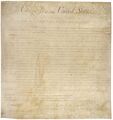Template:Selected anniversaries/June 8: Difference between revisions
No edit summary |
No edit summary |
||
| Line 12: | Line 12: | ||
File:Thomas Paine.jpg|link=Thomas Paine (nonfiction)|1809: [[Thomas Paine (nonfiction)|Thomas Paine]] dies. He authored the two most influential pamphlets at the start of the American Revolution, and inspired the rebels in 1776 to declare independence from Britain. | File:Thomas Paine.jpg|link=Thomas Paine (nonfiction)|1809: [[Thomas Paine (nonfiction)|Thomas Paine]] dies. He authored the two most influential pamphlets at the start of the American Revolution, and inspired the rebels in 1776 to declare independence from Britain. | ||
||1815: Giovanni Caselli born ... physicist, inventor and priest. He is the inventor of the pantelegraph (a.k.a. Universal Telegraph or "all-purpose telegraph"), the predecessor of the modern fax machine. The world's first practical operating facsimile machine ("fax") system put into use was by Caselli. Pic. | |||
||1851: Jacques-Arsène d'Arsonval born ... physician, physicist, and inventor of the moving-coil D'Arsonval galvanometer and the thermocouple ammeter. D'Arsonval was an important contributor to the emerging field of electrophysiology, the study of the effects of electricity on biological organisms, in the nineteenth century. | ||1851: Jacques-Arsène d'Arsonval born ... physician, physicist, and inventor of the moving-coil D'Arsonval galvanometer and the thermocouple ammeter. D'Arsonval was an important contributor to the emerging field of electrophysiology, the study of the effects of electricity on biological organisms, in the nineteenth century. | ||
| Line 43: | Line 45: | ||
||1936: Robert W (Bob) Floyd born ... computer scientist. His contributions include the design of the Floyd–Warshall algorithm (independently of Stephen Warshall), which efficiently finds all shortest paths in a graph, Floyd's cycle-finding algorithm for detecting cycles in a sequence, and his work on parsing. In one isolated paper he introduced the important concept of error diffusion for rendering images, also called Floyd–Steinberg dithering (though he distinguished dithering from diffusion). A significant achievement was pioneering the field of program verification using logical assertions with the 1967 paper Assigning Meanings to Programs. This was an important contribution to what later became Hoare logic. | ||1936: Robert W (Bob) Floyd born ... computer scientist. His contributions include the design of the Floyd–Warshall algorithm (independently of Stephen Warshall), which efficiently finds all shortest paths in a graph, Floyd's cycle-finding algorithm for detecting cycles in a sequence, and his work on parsing. In one isolated paper he introduced the important concept of error diffusion for rendering images, also called Floyd–Steinberg dithering (though he distinguished dithering from diffusion). A significant achievement was pioneering the field of program verification using logical assertions with the 1967 paper Assigning Meanings to Programs. This was an important contribution to what later became Hoare logic. | ||
||1942 | ||1942: World War II: The Japanese imperial submarines I-21 and I-24 shell the Australian cities of Sydney and Newcastle. | ||
||1949 | ||1949: Helen Keller, Dorothy Parker, Danny Kaye, Fredric March, John Garfield, Paul Muni and Edward G. Robinson are named in an FBI report as Communist Party members. | ||
||1949 | ||1949: George Orwell's ''Nineteen Eighty-Four'' is published. | ||
File:Tim Berners-Lee (2009).jpg|link=Tim Berners-Lee (nonfiction)|1955: Engineer and computer scientist [[Tim Berners-Lee (nonfiction)|Tim Berners-Lee]] born. He will invent the World Wide Web. | File:Tim Berners-Lee (2009).jpg|link=Tim Berners-Lee (nonfiction)|1955: Engineer and computer scientist [[Tim Berners-Lee (nonfiction)|Tim Berners-Lee]] born. He will invent the World Wide Web. | ||
||1967 | ||1967: Six-Day War: The USS Liberty incident occurs, killing 34 and wounding 171. | ||
|| | ||1972: Vietnam War: Nine-year-old Phan Thị Kim Phúc is burned by napalm, an event captured by Associated Press photographer Nick Ut moments later while the young girl is seen running down a road, in what would become an iconic, Pulitzer Prize-winning photo. | ||
|| | ||1979: Reinhard Gehlen dies ... German general who was chief of the Wehrmacht Foreign Armies East (FHO) military-intelligence unit, during World War II (1942–45); spymaster of the anti–Communist Gehlen Organization for the United States (1946–56); and the first president (1956–68) of the Federal Intelligence Service (Bundesnachrichtendienst, BND) of West Germany, during the Cold War. | ||
|| | ||1997: Karen Wetterhahn dies ... chemist and academic born ... mercury poison death. | ||
|| | ||1998: Maria Reiche born ... mathematician and archaeologist. | ||
|| | ||2000: Jeff MacNelly dies ... cartoonist ... Shoe. | ||
|| | ||2004: Charles Hyder dies ... astrophysicist and academic. | ||
|| | ||2004: The first Venus Transit in well over a century takes place, the previous one being in 1882. | ||
||Anatole Abragam | ||2011: Anatole Abragam dies ... physicist who wrote The Principles of Nuclear Magnetism and made significant contributions to the field of nuclear magnetic resonance. Pic. | ||
||2012 | ||2012: Charles E. M. Pearce dies ... mathematician and academic. | ||
</gallery> | </gallery> | ||
Revision as of 06:35, 1 September 2018
1625: Mathematician, astronomer, and engineer Giovanni Domenico Cassini born. He will discover four satellites of the planet Saturn and note the division of the rings of Saturn; the Cassini Division will be named after him.
1789: James Madison introduces nine amendments to the constitution in the House of Representatives, inluencing later Bill of Rights amendments.
1809: Thomas Paine dies. He authored the two most influential pamphlets at the start of the American Revolution, and inspired the rebels in 1776 to declare independence from Britain.
1887: Inventor Herman Hollerith applies for US patent #395,781 for the 'Art of Compiling Statistics', his punched card calculator.
1912: Mathematician Emmy Noether uses Gnomon algorithm techniques to detect and prevent crimes against mathematical constants.
1955: Engineer and computer scientist Tim Berners-Lee born. He will invent the World Wide Web.





